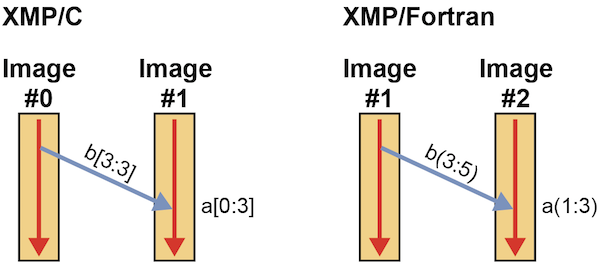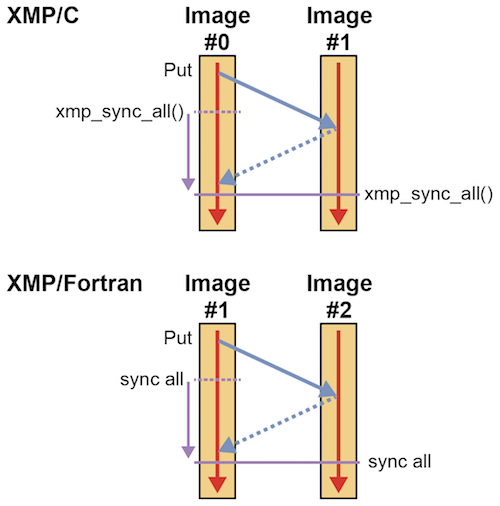3. Tutorial (Local-view)¶
3.1. Introduction¶
The user uses Coarray in the local-view model to describe one-sided communication. In XMP, put/get communication and some synchronization functions are supported.
If the target system supports Remote Direct Memory Access(RDMA) in the hardware, one-sided communication in the local-view model can achieve better performance compared to the global-view model. However, it requires more effort to describe parallel program since all communication should be specified in detail.
XMP/Fortran supports Coarray in the standard Fortran 2008. Coarray in XMP/C has its own original syntax since the C language does not support Coarray.
Note
XMP/Fortran has upward compatibility with Fortran 2008.
The basic unit of execution in the local-view is called “image” while it is called “node” in the global-view model. The two words have the same meaning in XMP.
3.2. Coarray declaration¶
- XMP/C program
int a[10]:[*];
- XMP/Fortran program
integer a(10)[*]
In XMP/C, the user declares a Coarray by adding :[] (Coarray dimension) after the array declaration. In XMP/Fortran, the user declares a Coarray by adding [] after the array declaration. The asterisk symbol is used in both languages.
Note
Based on Fortran 2008, the Coarray should have the same size of the entire execution node group.
Coarray can be accessed from other images using assignment statements. Of course, coarray can be also accessed from your image like ordinary array.
3.3. One-sided communication¶
3.3.1. Put communication¶
When the Coarray reference appears in the left-hand side in an assignment statement, it causes put communication.
- XMP/C program
int a[10]:[*], b[10];
if (xmpc_this_image() == 0)
a[0:3]:[1] = b[3:3];
- XMP/Fortran program
integer a(10)[*]
integer b(10)
if (this_image() == 1) then
a(1:3)[2] = b(3:5)
end if
The integer number in the Coarray dimension specifies the targer image. Each image index starts with 0 in XMP/C and starts with 1 in XMP/Fortran. xmpc_this_image() in XMP/C and this_image() XMP/Fortran return the current image index.
Note
In XMP/Fortran, image index starts with 1 while it uses [] (similar to C style for array dimension) to specify Coarray dimension based on the standard Fortran 2008.
Note
When Coarray dimension appears on both side, 3 nodes (target, source, current node) involve the communication.
In the above example, XMP/C puts b[3:3] on image 0 to a[0:3] on image 1. XMP/Fortran puts b(3:5) on image 1 to a(1:3) on image 2. The following figure illustrates the one-sided communication done by Corray.

Note
The directives in the global-view model invoke point-to-point communication. On the other hand, Coarrays in the local-view model invoke one-sided communication.
3.3.2. Get communication¶
When a Coarray appears in the right-hand side in the assignment statement, it causes get communication.
- XMP/C program
int a[10]:[*], b[10];
if (xmpc_this_image() == 0)
b[3:3] = a[0:3]:[1];
- XMP/Fortran program
integer a(10)[*]
integer b(10)
if (this_image() == 1) then
b(3:5) = a(1:3)[2]
end if
In the above program, XMP/C gets a[0:3] from image 1 and stores them on b[3:3] of image 0. XMP/Fortran gets a(1:3) from image 2 and stores them on b(3:5) of image 1. The following figure illustrates Coarray get communication.

Hint
As illustrated get needs an extra step to send a request to the target node. Put communication achieves better performance than get since there is no such extra step.
3.4. Synchronization¶
Here, we introduce “sync all” which is most frequently used among Coarray synchronization functions.
- XMP/C program
void xmp_sync_all(int *status)
- XMP/Fortran program
sync all
The “sync all” waits all issued one-sided communication and invokes barrier synchronization among the entire images.

In the above example, the left image puts data to the right image and both nodes invoke sync all. When both nodes finish sync all, the execution continues after the synchronization point.
3.5. Tutorial¶
Run the following sample using 2 images.
- XMP/C program
#include <stdio.h>
#include <xmp.h>
int a[10]:[*], b[10]:[*], c[10][10]:[*];
int main(){
int me = xmpc_this_image();
for(int i=0;i<10;i++)
a[i] = b[i] = i + 10 * me;
for(int i=0;i<10;i++)
for(int j=0;j<10;j++)
c[i][j] = (i * 10 + j) + 100 * me;
xmp_sync_all(NULL);
if(xmpc_this_image() == 0){
a[0:3] = a[5:3]:[1]; // Get
for(int i=0;i<10;i++)
printf("%d\n", a[i]);
b[0:5:2] = b[0:5:2]:[1]; // Get
printf("\n");
for(int i=0;i<10;i++)
printf("%d\n", b[i]);
c[0:5][0:5]:[1] = c[0:5][0:5]; // Put
}
xmp_sync_all(NULL);
if(xmpc_this_image() == 1){
printf("\n");
for(int i=0;i<10;i++){
for(int j=0;j<10;j++){
printf(" %3d",c[i][j]);
}
printf("\n");
}
}
return 0;
}
- XMP/Fortran program
program main
implicit none
include "xmp_coarray.h"
integer :: a(10)[*], b(10)[*], c(10,10)[*]
integer :: i, j, me
me = this_image()
do i=1, 10
b(i) = (i-1) + 10 * (me - 1)
a(i) = b(i)
end do
do i=1, 10
do j=1, 10
c(j,i) = ((i-1) * 10 + (j-1)) + 100 * (me - 1)
end do
end do
sync all
if (this_image() == 1) then
a(1:3) = a(6:8)[2] ! Get
do i=1, 10
write(*,*) a(i)
end do
b(1:10:2) = b(1:10:2)[2]; ! Get
write(*,*) ""
do i=1, 10
write(*,*) b(i)
end do
c(1:5,1:5)[2] = c(1:5,1:5) ! Put
end if
sync all
if (this_image() == 2) then
write(*,*) ""
do i=1, 10
write(*,*) c(:,i)
end do
end if
end program main
In the above example, 3 Coarrays a, b, c are declared. a and b are 1-dimensional arrays and c is a 2-dimensional array. The following shows the initial values of each array.
- Image 0 in XMP/C, Image 1 in XMP/Fortran
- a : from 0 to 9
- b : from 0 to 9
- c : from 0 to 99
- Image 1 in XMP/C, Image 2 in XMP/Fortran
- a : from 10 to 19
- b : from 10 to 19
- c : from 100 to 199
3.5.1. One-sided communication for contiguous region¶
In the first get communication, in XMP/C, image 0 gets a[5:3] from image 1 and stores them to a[0:3]. In XMP/Fortran, image 1 gets a[6:8] from image 2 and stores them to a(1:3)
After the communication, array a has the following values.
15
16
17
3
4
5
6
7
8
9
3.5.2. One-sided communication for discontiguous region¶
In the second get communication, in XMP/C, image 0 gets b[0:5:2] from image 1 and stores them to b[0:5:2]. In XMP/Fortran, image 1 gets b(1:10:2) from image 2 and stores them to b(1:10:2).
After the communication, array b has the following values.
10
1
12
3
14
5
16
7
18
9
3.5.3. One-sided communication for multi-dimensional array¶
In the put communication, in XMP/C, image 0 puts c[0:5][0:5] to on c[0:5][0:5] image 1. In XMP/Fortran, image 1 puts c(1:5,1:5) to c(1:5,1:5) on image 2. The communication has the block-strided communication pattern.
After the communication, array c has the following values.
0 1 2 3 4 105 106 107 108 109
10 11 12 13 14 115 116 117 118 119
20 21 22 23 24 125 126 127 128 129
30 31 32 33 34 135 136 137 138 139
40 41 42 43 44 145 146 147 148 149
150 151 152 153 154 155 156 157 158 159
160 161 162 163 164 165 166 167 168 169
170 171 172 173 174 175 176 177 178 179
180 181 182 183 184 185 186 187 188 189
190 191 192 193 194 195 196 197 198 199